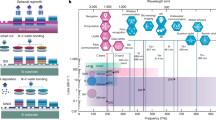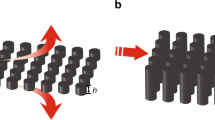Abstract
Photonic circuits, in which beams of light redirect the flow of other beams of light, are a long-standing goal for developing highly integrated optical communication components1,2,3. Furthermore, it is highly desirable to use silicon—the dominant material in the microelectronic industry—as the platform for such circuits. Photonic structures that bend, split, couple and filter light have recently been demonstrated in silicon4,5, but the flow of light in these structures is predetermined and cannot be readily modulated during operation. All-optical switches and modulators have been demonstrated with III–V compound semiconductors6,7, but achieving the same in silicon is challenging owing to its relatively weak nonlinear optical properties. Indeed, all-optical switching in silicon has only been achieved by using extremely high powers8,9,10,11,12,13,14,15 in large or non-planar structures, where the modulated light is propagating out-of-plane. Such high powers, large dimensions and non-planar geometries are inappropriate for effective on-chip integration. Here we present the experimental demonstration of fast all-optical switching on silicon using highly light-confining structures to enhance the sensitivity of light to small changes in refractive index. The transmission of the structure can be modulated by up to 94% in less than 500 ps using light pulses with energies as low as 25 pJ. These results confirm the recent theoretical prediction16 of efficient optical switching in silicon using resonant structures.
This is a preview of subscription content, access via your institution
Access options
Subscribe to this journal
Receive 51 print issues and online access
$199.00 per year
only $3.90 per issue
Buy this article
- Purchase on Springer Link
- Instant access to full article PDF
Prices may be subject to local taxes which are calculated during checkout



Similar content being viewed by others
References
Luo, C., Joannopoulos, J. D. & Fan, S. Nonlinear photonic crystal microdevices for optical integration. Opt. Lett. 28, 637–639 (2003)
Krauss, T. F. Planar photonic crystal waveguide devices for integrated optics. Phys. Status Solidi A 197, 688–702 (2003)
Yablonovitch, E. Photonic crystals: semiconductors of light. Sci. Am. 285, 47–55 (2001)
Loncar, M., Doll, T., Vuckovic, J. & Scherer, A. Design and fabrication of silicon photonic crystal optical waveguides. J. Lightwave Technol. 18, 1402–1411 (2000)
Wada, K., Luan, H. C., Lim, D. R. C. & Kimerling, L. C. On-chip interconnection beyond semiconductor roadmap: Silicon microphotonics. Proc. SPIE 4870, 437–443 (2002)
Ibrahim, T. A. et al. All-optical switching in a laterally coupled microring resonator by carrier injection. IEEE Photon. Technol. Lett. 15, 36–38 (2003)
Van, V. et al. All-optical nonlinear switching in GaAs–AlGaAs microring resonators. IEEE Photon. Technol. Lett. 14, 74–76 (2002)
Leonard, S. W., van Driel, H. M., Birner, A. & Gösele, U. All-optical ultrafast tuning of two-dimensional silicon photonic crystals via free-carrier injection. Summaries of Papers Presented at the Quantum Electronics and Laser Science Conference. Postconference Technical Digest 159 (Optical Society of America, Washington DC, 2001)
Tan, H. W., van Driel, H. M., Schweizer, S. L., Wehrspohn, R. B. & Gösele, U. Tuning a 2-D silicon photonic crystal using nonlinear optics. Conf. on Laser and Electro-Optics 2004 Vol. IFD2 (Optical Society of America, Washington DC, 2004)
Hache, A. & Bourgeois, M. Ultrafast all-optical switching in a silicon-based photonic crystal. Appl. Phys. Lett. 77, 4089–4091 (2000)
Normandin, R., Houghton, D. C. & Simard-Normandin, M. All-optical, silicon based, fiber optic modulator using a near cutoff region. Can. J. Phys. 67, 412–419 (1989)
Cocorullo, G. et al. Fast infrared light modulation in a-Si:H micro-devices for fiber-to-the-home applications. J. Non-Cryst. Solids 266–269, 1247–1251 (2000)
Tsang, H. K. et al. Optical dispersion, two-photon absorption and self-phase modulation in silicon waveguides at 1.5 µm wavelength. Appl. Phys. Lett. 80, 416–418 (2002)
Henari, F. Z., Morgenstern, K., Blau, W. J., Karavanskii, V. A. & Dneprovskii, V. S. Third-order optical nonlinearity and all-optical switching in porous silicon. Appl. Phys. Lett. 67, 323–325 (1995)
Soref, R. A. & Lorenzo, J. P. Light-by-light modulation in silicon-on-insulator waveguides. Digest of the OSA Integrated and Guided-Wave Optics Topical Meeting 86–89 (Optical Society of America, Washington DC, 1989)
Barrios, C. A., Almeida, V. R. & Lipson, M. Low-power-consumption short-length and high-modulation-depth silicon electrooptic modulator. J. Lightwave Technol. 21, 1089–1098 (2003)
Soref, R. A. & Bennett, B. R. Kramers-Kronig analysis of electro-optical switching in silicon. Proc. SPIE 704, 32–37 (1987)
Zhao, C. Z., Li, G. Z., Liu, E. K., Gao, Y. & Liu, X. D. Silicon on insulator Mach–Zehnder waveguide interferometers operating at 1.3 µm. Appl. Phys. Lett. 67, 2448–2449 (1995)
Stepanov, S. & Ruschin, S. Modulation of light by light in silicon-on-insulator waveguides. Appl. Phys. Lett. 83, 5151–5153 (2003)
Liu, A. et al. A high-speed silicon optical modulator based on a metal-oxide-semiconductor capacitor. Nature 427, 615–618 (2004)
Almeida, V. R., Panepucci, R. R. & Lipson, M. Nanotaper for compact mode conversion. Opt. Lett. 28, 1302–1304 (2003)
Verdeyen, J. T. Laser Electronics, 3rd edn 153 (Prentice Hall, Upper Saddle River, NJ, 2000)
Chin, A., Lee, K. Y., Lin, B. C. & Horng, S. Picosecond photoresponse of carriers in Si ion-implanted Si. Appl. Phys. Lett. 69, 653–655 (1996)
Meindl, J. D. et al. Interconnect opportunities for gigascale integration. IBM Res. Dev. 46, 245–263 (2002)
Weiss, S. M., Molinari, M. & Fauchet, P. M. Temperature stability for silicon-based photonic band-gap structures. Appl. Phys. Lett. 83, 1980–1982 (2003)
Cheben, P., Xu, D.-X., Janz, S. & Delâge, A. Scaling down photonic waveguide devices on the SOI platform. Proc. SPIE 5117, 147–156 (2003)
Vlasov, Y. A. & McNab, S. J. Losses in single-mode silicon-on-insulator strip waveguides and bends. Opt. Express 12, 1622–1631 (2004)
Pardo, F. et al. Optical MEMS devices for telecom systems. Proc. SPIE 5116, 435–444 (2003)
Miller, D. A. B. Optical interconnects to silicon. IEEE J. Sel. Top. Quant. Electron. 6, 1312–1317 (2000)
Acknowledgements
We acknowledge support by the Cornell Center for Nanoscale Systems, funded by the National Science Foundation (NSF), by the Air Force Office of Scientific Research (AFOSR) and by the CS-WDM programme of the Defense Advanced Research Project Agency. V.R.A. acknowledges sponsorship support provided by the Brazilian Defence Ministry. This work was performed in part at the Cornell Nano-Scale Science & Technology Facility (CNF), a member of the National Nanotechnology Infrastructure Network (NNIN) which is supported by the NSF, its users, Cornell University and Industrial Affiliates.
Author information
Authors and Affiliations
Corresponding author
Ethics declarations
Competing interests
The authors declare that they have no competing financial interests.
Rights and permissions
About this article
Cite this article
Almeida, V., Barrios, C., Panepucci, R. et al. All-optical control of light on a silicon chip. Nature 431, 1081–1084 (2004). https://doi.org/10.1038/nature02921
Received:
Accepted:
Issue Date:
DOI: https://doi.org/10.1038/nature02921
This article is cited by
-
Inorganic perovskite-based active multifunctional integrated photonic devices
Nature Communications (2024)
-
All-optical free-space routing of upconverted light by metasurfaces via nonlinear interferometry
Nature Nanotechnology (2024)
-
Design and analysis of inverse tapered silicon nitride waveguide for flat and highly coherent supercontinuum generation in the mid-infrared
Optical and Quantum Electronics (2024)
-
Engineering the temporal dynamics of all-optical switching with fast and slow materials
Nature Communications (2023)
-
Manipulation of nonlinear optical responses in layered ferroelectric niobium oxide dihalides
Nature Communications (2023)
Comments
By submitting a comment you agree to abide by our Terms and Community Guidelines. If you find something abusive or that does not comply with our terms or guidelines please flag it as inappropriate.



